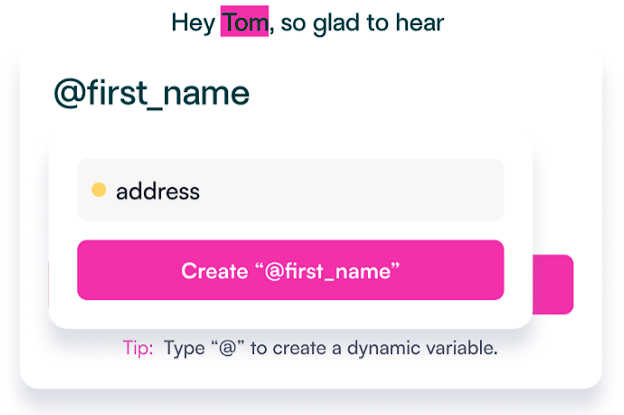All Posts
12+ Top Enterprise Video Platforms for Your Business [2025]


Enterprise video platforms are becoming a business necessity, with more and more organizations realizing just how powerful videos can be. Reports state that conversion rates can increase by 30% thanks to integrating live videos with ecommerce. More than 90% of marketers boast good ROI on video content—with 51% saying that video has the best ROI of all their content.
For developers, integrating video capabilities within applications and workflows unlocks a wide range of possibilities, from live streaming and virtual events to scalable, personalized video marketing. Videos are also great for improving internal processes, including team communication, onboarding, and training.
Explore these top enterprise video platforms to find the best tools for embedding video functionality and scaling video creation within your applications.
An enterprise video platform, or EVP, is a marketing tool businesses use to host, manage, and deliver content to their intended audience. For developers, EVPs provide APIs that enable seamless integration of video capabilities into existing workflows with minimal coding effort.
An EVP helps organizations handle their content from a central location, making them more efficient. This also bypasses some of the limitations that consumer-grade video hosting platforms have, like, branding opportunities, access, integration with other business systems, and advanced analytics.
An enterprise video platform also offers features that let companies create and edit content without the need for third-party applications. There are even some that provide analytics and AI video generator tools.
Enterprise video platforms play a crucial role beyond merely hosting videos, providing developers with the APIs and integrations to support diverse business needs. Rather than just being a storage space, EVPs are integral for businesses looking to share content effectively, whether with their existing customer base or internal teams.
For developers, they serve as multifaceted platforms for supporting employee training, marketing initiatives, internal communications, and more. One significant aspect of enterprise video platforms is their function as video libraries, providing a centralized space where company members can store and retrieve video content as needed. This not only streamlines accessibility but also facilitates organized content management within the organization.
Moreover, EVPs offer a valuable feature in the form of video distribution to external channels, such as content delivery networks (CDNs). This capability ensures that the videos produced by companies can effectively reach their intended audience, enhancing the impact of marketing efforts and communication strategies.
In essence, EVPs are versatile, API-enabled that allow developers to seamlessly share, manage, and distribute video content for various purposes, ultimately contributing to more effective communication and engagement.
Enterprise video platforms have several features that make them essential for businesses planning to expand their video production. Below are just some of the functions they should look for.
For developers, seamless integrations and API support are key features to look for in an enterprise video platform to expand functionality and enhance user experience within your app or platform.
Developers can use the Tavus Conversational Video Interface (CVI) API to embed real-time, face-to-face AI humans directly into applications—and also generate high-quality personalized videos when async is a better fit. The Tavus API is flexible and developer-friendly, with clear documentation, extensive configuration, and tooling to scale across use cases. You can tailor each interaction to the individual with features like Knowledge Base and Memories, then automate distribution through webhooks and integrations.
For instance, you can embed Tavus-powered AI humans inside your product for onboarding or support, or trigger personalized video sends from your email platform as soon as a new video is created.
Developers should look for enterprise video platforms that offer a built-in editing tool, preferably one capable of producing professional-grade results.
Not only will this make it easier for users to create videos, but it will also cut down costs since it eliminates the need to pay for third-party software.
Developers should be able to customize their videos however they want. That’s why they look for EVPs that offer white-label options.
For instance, having the ability to integrate video generation within your applications without external branding is crucial. Even having the option to change video backgrounds can increase engagement.
Every piece of content that users upload to an EVP should be kept secure. Ensuring the reputability of the prospective enterprise video platform is key.
Don’t work with fly-by-night platforms that don’t offer security and privacy. Who gets access control over the videos? Is content encrypted? Is there user authentication? These are all things to consider when dealing with something as sensitive as using someone’s likeness to create videos.
A good enterprise video platform must have built-in analytics. It’s the best way to track video performance.
Through analytics, developers can inform the whole team about how many people saw the videos, where they are from, and what type of content they like.
Here are some of the best enterprise video platforms available to businesses at this time.

Tavus gives developers a real-time way to bring humanlike communication into their products. With the Conversational Video Interface (CVI) API, you can embed face-to-face AI humans that see, hear, and respond in real time—and you can also generate personalized videos at scale when async content makes more sense. Studio‑grade full‑face rendering, natural turn‑taking, and real-time perception make conversations feel truly human.
Here’s how it works:
Tavus makes it as easy as possible to add humanlike video experiences into your applications.

Features & Benefits:
Best for: Embedding real‑time, face‑to‑face AI humans into products and scaling personalized video campaigns
Ready to see Tavus in action? Request your free demo

Vidyard allows users to host, create, manage, and analyze video content. It provides features like screen recording and webcam capturing to create videos. Embed these videos in social media, email, and websites. The platform also allows users to add interactive elements to videos, like Calls to Action, and customize content.
Another Vidyard feature allows businesses to analyze video performance by tracking viewer engagement, number of views, and the viewer's locations. Vidyard offers integrations with various tools, including CRM systems, content management platforms, and email marketing software.
Features & Benefits:
Pricing:
Best for: Salespeople who prioritize email marketing

Vimeo provides businesses with the tools they need to create and manage their videos in one place. It also has features that enable them to stream and host in 4K and 8K HDR.
This platform also has a security feature that lets users set permissions so no one can access videos they aren’t supposed to. Businesses have the option to embed their videos anywhere using Vimeos ad-free player.
Features & Benefits:
Pricing:
Best for: Businesses that like to stream and host webinars to connect with their audience.

VBrick is a video content management solution focused on helping businesses with their web conferencing needs. It gives users a platform to broadcast to thousands of people at a time.
It has its own CDN, which means users can deliver videos at scale. The platform also comes with end-to-end security in the cloud. This includes SOC2 compliance and secured eCDN streaming.
Features & Benefits:
Pricing: Pricing is only available by request.
Best for: Businesses in the financial, healthcare, and technology space that need web conferencing solutions

Kaltura lets individuals or businesses share their content through virtual events, webinars, virtual classrooms, and video portals. It also enables businesses to broadcast to unlimited audiences through its Town Halls feature.
Users collaborate in real-time with teams and create video messages for their audience.
Features & Benefits:
Pricing: Pricing for Kaltura video management is not publicly available.
Best for: Businesses built around streaming content, webinars, and virtual events

IBM Cloud Video gives businesses the resources to launch virtual events and livestreams. Its features include auto-archive as well as video-on-demand. Some also use the product for town hall meetings and virtual product launches.
It can leverage AI software for automatic closed captioning and video search.
Features & Benefits:
Pricing:
Best for: Businesses looking for cloud-based solutions for streaming and sharing corporate videos

Dacast is an excellent option if the main goal is monetization through pay-per-view streaming. Users can set their prices, promo codes, and viewing windows. This platform can facilitate global payments using an advanced paywall built into its player.
This platform is capable of streaming content throughout the world.
Features & Benefits:
Pricing:
Best for: Businesses, non-profits, and religious organizations looking to monetize their video creation

JW Player lets business owners livestream events 24/7 and make them available as video-on-demand afterward. This platform can do so in 4K resolution.
Users can create a FAST (free ad-supported streaming television) channel. JW Player uses HTML5, which results in a reliable viewing experience.
Features & Benefits:
Pricing: Only custom plans are available
Best for: Businesses looking to monetize their VOD and live streaming content

Microsoft Stream allows users to record themselves along with their screens. Users can then add drawings, text, or effects to personalize videos to their liking.
They can also share these videos with other users who are using Microsoft Teams. Audiences access these videos anywhere, whenever they want.
Features & Benefits:
Pricing:
Best for: Businesses that are already heavily invested in the Microsoft ecosystem.

Wistia is a video marketing platform for producing, hosting, and analyzing the effectiveness of videos. With a mission to support businesses in leveraging video, Wistia offers a range of features, including customizable video players, integrations, analytics, lead generation tools, and more.
Features & Benefits:
Pricing:
Best for: Webinar hosting

While YouTube isn’t necessarily a traditional enterprise video platform, this video hosting platform allows users to share, watch, comment on and upload videos for free. It has a wide audience, but the downside of using YouTube is that businesses don’t have control over their videos. YouTube can take them down any time if it thinks they violate their terms of service.
Also, YouTube earns revenue through the advertisements they add to your videos, which can spoil your viewers’ experience.
Features & Benefits:
Pricing: Users can upload their videos on YouTube for free.
Best for: Businesses that want to leverage YouTube’s massive audience to promote their respective brands.

Panopto is a great tool not only for businesses but for educators as well. This is especially true for those who want to record multiple video feeds simultaneously.
Users add content to their personal libraries. The platform leverages AI to help users find videos (or specific moments in them) faster.
Features & Benefits:
Pricing: Only custom plans are available
Best for: Businesses and educators that use multi-camera setups for their videos
When shopping for the best enterprise video platform, the choice that best suits your needs depends on the specific features that align with your platform objectives. As we've explored the top contenders, each platform brings its unique strengths to the table.
However, for developers looking for the best in personalization and real-time interaction, Tavus emerges as the standout choice. With the CVI API, you can embed lifelike, face‑to‑face AI humans that see, hear, and respond in real time—and when async is the right fit, you can generate personalized videos at scale from a single setup. That combination lets you deliver humanlike presence where it matters most, while keeping your workflows fast and scalable.
Are you ready to elevate your team's scalability and enhance ROI?